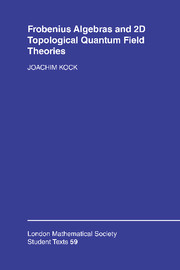1 - Cobordisms and topological quantum field theories
Published online by Cambridge University Press: 19 January 2010
Summary
Summary
In the first section we recall some basic notions of manifolds with boundary and orientations, and Morse functions. We introduce the slightly nonstandard notion of in-boundary and out-boundary, which is particularly convenient for the treatment of cobordisms.
Section 1.2 is devoted to the basic theory of oriented cobordisms. Roughly a cobordism between two closed (n − 1)-manifolds is an n-manifold whose boundary is made up of the two (n − 1)-manifolds.We describe what it means for two cobordisms to be equivalent. Next we introduce the decomposition of a cobordism, which amounts to cutting up along a closed codimension-1 submanifold, obtaining two cobordisms. Finally we state the axioms for a topological quantum field theory (TQFT) in the style of Atiyah [5]: it is a way of associating vector spaces and linear maps to (n − 1)-manifolds and cobordisms, respecting decompositions and disjoint union. A special decomposition of the cylinder shows that a vector space which is image of a TQFT comes equipped with a nondegenerate bilinear pairing, in a strong sense, which in particular forces the vector space to be finite dimensional.
In Section 1.3 we assemble the manifolds and cobordisms into a category nCob. In order to have a well defined composition we must pass to a quotient, identifying equivalent cobordisms. The identity arrows are the cylinder classes. Then we start discussing the monoidal structure: disjoint union of cobordisms. With this terminology we can define a TQFT as a (symmetric) monoidal functor from nCob to Vect K. (The definition and basic properties of monoidal categories are given in Chapter 3.)
- Type
- Chapter
- Information
- Publisher: Cambridge University PressPrint publication year: 2003

